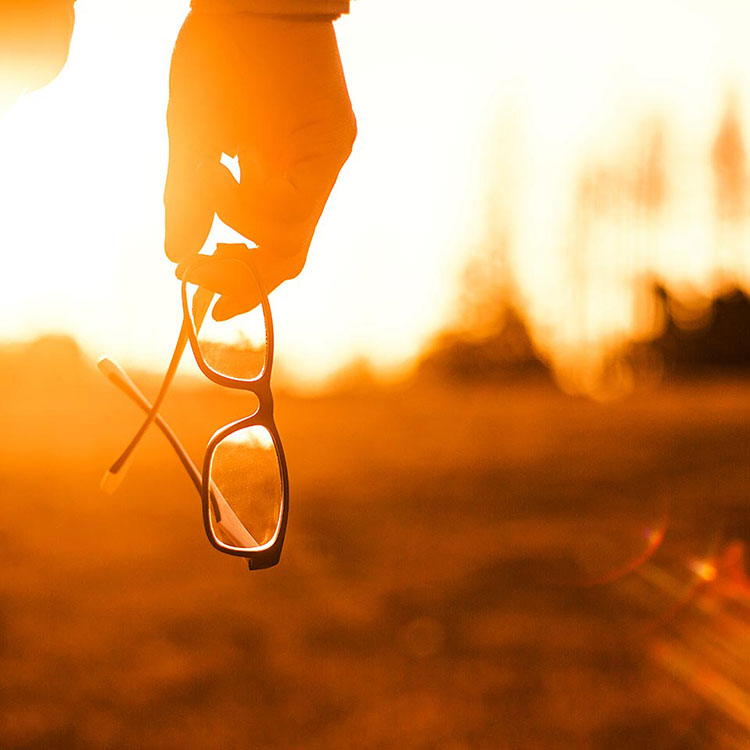After a long, frozen winter, we cheer when the sun finally begins to warm the Earth. But beware of the power of this life-giving, dazzling star! As we spend more time outdoors at beaches, ballgames, parks and pools, the sun’s constant UV (ultraviolet) light radiation can damage our eyes.
Over time, too much UV exposure can lead to cataracts or macular degeneration, leading causes of vision loss among seniors. The sun can also cause skin cancer around the eyelids, abnormal growths on the surface of the eye and even (though rarely) sunburn of the eye. UV-A rays penetrate the most deeply, causing the skin to tan and doing the most long-term damage to both eyes and skin. UV-B is the shorter ultraviolet light wavelength that causes burns to the skin and the front of the eye.
When skin is left unprotected, we may develop painful sunburn; when eyes go unprotected, however, we remain largely unaware of the harm being done. Eye damage from long-term exposure to the sun’s UV rays is so gradual that it is not felt. This underscores the importance of protecting our eyes when outdoors.
Scientists have found a link between development of cataracts and depletion of the Earth’s ozone layer.
Test your sun smarts
We all know the value of guarding against sunburn and skin cancer by slathering on sunscreen, and most of us wear sunglasses in summer to shield our eyes from glare. When it comes to preserving eyesight over the long term, however, many of us have misconceptions about the sun’s dangers. Do you know the facts behind these myths?
- Myth #1: Sunglasses are not necessary in winter.
Fact: The damaging effects of UV rays are present during winter as well as summer. Sunglasses with UV protection are necessary whenever you spend time outdoors during daylight hours, all year round. - Myth #2: On overcast days, UV rays are not harmful.
Fact: Just because the sun is not glaring brightly does not mean its UV rays are not affecting the eyes. If there’s daylight, UV rays are present. They penetrate through haze and clouds, and reflect off water, white sand, pavement and snow. - Myth #3: Our eyesight deteriorates with age simply because we get older.
Fact: This is true to some extent, but the fact is that a lifetime of exposure to UV light increases the likelihood of developing macular degeneration, cataracts and other eye conditions. There is scientific evidence of a link between development of cataracts and depletion of the Earth’s ozone layer, which allows more unfiltered UV light to reach us. If we protect our eyes, however, our chances of maintaining good eye health into old age are greatly increased. - Myth #4: Adults’ eyes are at a higher risk of sun damage than children’s.
Fact: Just the opposite is true. Children’s eyes are especially vulnerable to sun damage because they are still developing. Their pupils are larger, allowing in more light, and the lenses of their eyes are more transparent. They also spend more time outdoors than most adults. Brief but intense UV contact may cause corneal sunburn, the most immediate danger to children’s eyes from sun overexposure. No long-term damage results, but it can be painful for a few days. - Myth #5: Only the sun emits ultraviolet light.
Fact: Artificial light sources, such as tanning beds and welding machines, also produce UV radiation and require eye protection during use.
Remember: Shades, Hat, Veggies
Here are the best ways to protect your eyes:
- When spending time outdoors, wear protective eyewear, such as Transitions® lenses or polarized sunglasses, that blocks 99 to 100 percent of UV-A and UV-B rays.
- Wear a wide-brimmed hat or cap, which will block about half of UV rays.
Children’s eyes are especially vulnerable to sun damage because they are still developing.
- Remember that UV rays reflect off bright surfaces such as water, snow, white sand and pavement, making it critical—especially for children—to wear sunglasses and hats in the snow or at the beach, swimming pool or playground.
- Always wear protective goggles when using a tanning bed or welding machine.
- Eat a healthy diet. There is scientific evidence that a diet rich in brightly colored fruits and vegetables helps reduce the risk of sun damage to your eyes.
Many bright summer days are ahead. Enjoy outdoor activities safely by protecting your eyes—and those of your children—from the sun!
Source: Prevent Blindness America, American Optometric Association, Vision Monday, U.S. News & World Report, The Canadian Press

